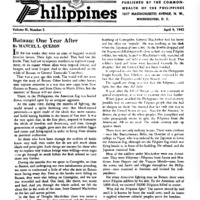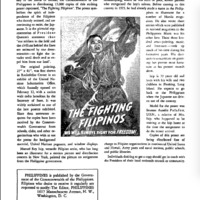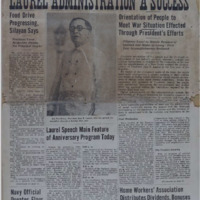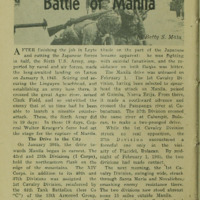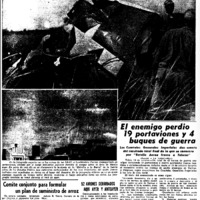As war devastated Europe, The Young Citizen, in its last number held at the UPD collection, told its readers that “war is a terrible thing [...] because it includes not only soldiers but also the little children and their mothers”, and asked if there was something to be done to avoid this destruction. The Japanese attack on Pearl Harbor on December 7th, 1941, and especially with the destruction of Clark Field Airbase (Pampanga) on December 8th, 1941 (the second biggest US-Air Force camp outside of North America), answered that question. Within a month, the Japanese Imperial Army occupied Manila (January 2nd, 1942) and General McCarthur decided to withdraw to the Bataan Peninsula and the island fortress of Corregidor, ill-equipped and inadequately supplied, which led first to the Bataan Death March on April 9th, 1942 and then to the devastating Japanese attack on Corregidor on May 5th-6th, 1942.
On December 24, 1941, President Manuel Quezon and the Commonwealth Government evacuated to the United States, where it continued to function in exile, first under Quezon's leadership and then under Sergio Osmeña, who succeeded Quezon after his death on August 1, 1944 (Official Gazette of the Philippines). From Washington, the Commonwealth Government would publish Philippines, of which the UPD collection includes 6 numbers between March 15th and August 31st, 1943. Philippines included several articles by Quezon himself and would try to inform of the agreements made by the government in exile and offer some news of the situation of the archipelago. It would also publish a press version of the famous poster The Fighting Filipinos, by Manuel Rey Isip, shown at the Rockefeller center in a United Nations exhibit in February 1943.
As Vicente Rafael argues (2000, 109), with few exceptions and with varying degrees of reluctance or alacrity, the overwhelming majority of the country's ruling class collaborated with the Japanese Military Administration. As soon as October 14th, 1943, Dr. Jose P. Laurel took the oath as President of the Japanese-sponsored Philippine Republic. The UPD collection also includes The Republic, a weekly publication in English and Tagalog centered on administrative and political issues of the Laurel administration and the unique party, the Kapisanan ng Paglilingkod sa Bagong Pilipinas, although it occasionally informed on the war the Republic of the Philippines would declare war to the Allies on September 23, 1944, making the Philippines belligerent in the conflict from both the Axis and the Allies’ side.
As Ricardo Jose Trota illustrates (1990) , the Japanese military administration issued censorship under military law’ penalties on the 7th of February mandatory, and since then, all press releases required approval of the Director General of the Japanese Military Administration. Trota argues that writers played safe and didn’t write outwardly pro-Japanese articles, focusing instead on unproblematic topics, such as sports and society news, even writing articles on Philippine culture and history which were, in fact, encouraged by the Japanese in spite of their nationalistic overtones. Nevertheless, political news were controlled at the source and were given to a selected few, which were anyway off limits regarding any news over the battlefront, written directly by Japanese officials fluent in the different languages of the archipelago, even in Spanish.
Periodicals such as La Vanguardia, or Tribune, owned by Alejandro Roces and his TVT Publishing Corporation, as Ricardo Trota has shown in its case study of the latest, changed from being balanced publications (although never fully supportive of the Americans) to a propaganda mouthpiece for the Japanese due to a combined fear of Japanese reprisals and the control of the Japanese Army’s Propaganda Corps. The inauguration of the Manila Newspaper Company (Manila Shinhun-Sha) was held at the offices of the Tribune, together with a symbolic acquisition of the TVT group by the Army from Alejandro Roces. Pedro Aunario, editor of La Vanguardia, and important collaborators of the publication such as Leon María Guerrero (under the pseudonym Ignacio Javier) or Aurelio Alvero, continued working for the Japanese-controlled Tribune as a regular staff.
The UPD collection holds 93 numbers of La Vanguardia, ranging from the 1st of March 1944 to October 26th, 1944, when the US Sixth Army won a decisive victory in the Battle of Leyte Gulf, and also from Philippine Review, published in English by Philippine Publications and edited by Francisco B. Icasiano, between March 1943 to October 1944. Philippine Review also reported on the war favorably of the axis, but was focused on culture and included mostly specialized articles ranging from poetry, law, history to economy, and written by Filipino nationalists such as Claro M. Recto, Manuel Bernabé, Nick Joaquin or Emilio Aguinaldo, but also Japanese authors, within a pro-Japanese Pan-Asianist perspective. Part of the general Japanese strategy of acculturation and war mobilization were Japanese propaganda films, such as Tank Commander Nishizumi, advertised in Philippine Review, or the Japanese lessons published daily by La Vanguardia.
Through these publications, a pro-Japanese reading of the war can be reconstructed, marked by a silencing of Japanese defeats and the setbacks of its European allies, that were depicted as defeats of the enemies of the axis-powers, “los anti-eje”. During 1944 defense preparations were depicted daily on the news, and after the return of General MacArthur to the archipelago on October 20th, 1944, American advances and air raids were portrayed as a threat to Philippine independence (Trota Jose 1990, 141). This was the case even after the Battle of Leyte was fought and lost between the 20th and 26th of October 1944, to the point that Japanese propaganda continued to the very end of the occupation, which also ended up with the destruction of TVT buildings, records, and presses by the Japanese the day Americans entered Manila, putting an end both to The Tribune and La Vanguardia.
Although the government called for a defense of the Asian great destiny and the miraculous promise of a Japanese Victory, on December 16th, 1944 Moro guerrilla units liberated Mindanao and Mindoro. On February 3d the Allied forces launched their assault on Manila, liberating the city on the following day, 4th, 1945. As Rocío Ortuño (2018, 1-2) synthesized, the Japanese army committed several war crimes, causing devastation only comparable to the destruction of Warsaw, with 100.000 victims of war, almost as many as the victims of Hiroshima’s atomic bombing, which ultimately caused Japan’s unconditional capitulation on August 14, 1945.
From the perspective of our collection, the second world war had a huge impact on most of the publications, especially in the Spanish-speaking press (Godoy 2015), to the point that the only newspaper in Spanish after the IIWW would be La Voz de Manila, which faced financial troubles from the very beginning (Rodao 2009, 21). But, as the collection, shows, on June 7th, 1945 there was already an Allied press established in the archipelago announcing the victory of the Allied Army in Luzon’s, Negros’, and Okinawa’s Campaigns, and also a soon victory over Japan.
The second world war would be not only a historical event but also a place of memory for the permanent ties of friendship and defense of the democracy between the Philippines and the US. The role of the archipelago in the upcoming cold war would be marked by this legacy.
Bibliographic references
Agoncillo, Teodoro A. 1965. The Fateful Years; Japan’s Adventure in the Philippines, 1941-45. Quezon City: R.P. Garcia Pub. Co.
Checa Godoy, Antonio. 2015. “La prensa filipina en español entre dos guerras (1899-1941)”. RIHC. Revista Internacional de Historia de la Comunicación 1 (4): 22-51.
Connaughton, Richard. 2003. MacArthur and Defeat in the Philippines. New York: Overlook Press.
Escoda, José Ma. Bonifacio M. 2000. Warsaw of Asia: The Rape of Manila. Quezon City: Giraffe Books.
Gruhl, Werner. 2010. Imperial Japan’s World War Two, 1931-1945. New Brunswick, New Jersey: Transaction.
Ortuño Casanova, Rocío . 2018. “Los sonidos de la II Guerra Mundial en Manila: ruido y autorepresentación en Nuestros cinco últimos días bajo el yugo nipón, de María Paz Zamora-Mascuñana”. Revista de crítica literaria latinoamericana, num. 88: 291-314.
Rafael, Vicente L. 2000. White Love and other Events in Filipino History. Durham: Duke University Press.
Rodao, Florentino. 2009. “La ocupación japonesa en Filipinas y etnicidad hispana (1941-1945)”. Gerónimo de Uztariz, num. 25: 9-26.
Trota Jose, Ricardo. 1990. “The Tribune as a Tool of Japanese Propaganda, 1942-45”. Philippine Studies 38 (2): 135-50.
1990. “The ‘Tribune’ During the Japanese Occupation”. Philippine Studies 38 (1): 45-64.

